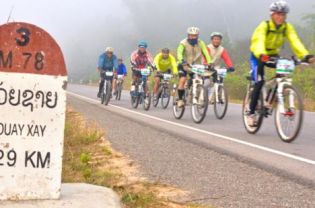Originally posted as ‘Discover a New Side of Thailand on Your Bike’ in
Life & Times section of Jakarta Globe 1/04/2012. Article by Mick Elmore

Seven hours and 90 kilometers into Laos, and cyclists are nearing the top of the day’s third steep climb. The bicycles are crawling, but the riders are smiling as they finish the last tough grind of the day.
It started on the Mekong River marking the Thai-Lao border, then followed a well-maintained two-lane paved strip over two steep 730-meter-high passes to a school below a mountain. Then after a buffet lunch there, the three-dozen riders faced a four-kilometer, 400-meter climb in the heat of the afternoon to over 1,000 meters above sea level. It was brutal, but no one complained.
At the top, Wanchai Phutthawarin of Chiang Rai, northern Thailand, greeted riders. “Viang Phuka is only an hour. Easy riding,” he said waving his left hand at the road descending the last 30 kilometers to our stop for the night, a big bottle of Beer Lao on his right. Always polite, he offered the bottle around.
Wanchai is one of the organizers and crew on the eight-day pedal from Thailand through northern Laos and into southern China. He was an early enthusiast for Thailand’s growing cycling trend of the past decade. Good bicycles were a rarity even in the ’90s, and while still not common, it is no longer a surprise to see one.
Cycling clubs and organized rides abound countrywide, including during Bangkok’s monthly car-free day, and a growing number of Thais have made long international rides, including a few who have pedaled around the world. A host of bicycle tour companies offer trips of various lengths and comfort in Thailand, too.
The Tourism Authority of Thailand got involved in 2002, putting its vast resources into organizing journeys through the region — the cycling trips, called Mekong Challenges in past years and the Eco Bike Tour in 2012, took some organizing. Food, accommodation and support vehicles are arranged, allowing the rider to concentrate on cycling. As with most things Thais do, cycling trips are about “sanuk,” which basically means to have fun and enjoy, but in a Thai way. It’s one of those words that doesn’t easily translate into English.
Wanchai and I have been here before. In 2008 we rode the same route. Then, it was 35 cyclists from seven countries riding 600 kilometers through three countries in six days speaking one common language every pedal of the way: bicycle.
In 2009, riding in a similar international group, we passed this way going the opposite direction. This year included riders from a dozen of Thailand’s 77 provinces, including Chiang Rai, bordering Burma to the north. But I was the only foreigner.
Thais, if anything, are a welcoming people. They are delighted when a foreigner speaks reasonable Thai, but they take a perverse pleasure when they make mistakes. Sitting in a sidewalk restaurant in Luang Namtha, Laos after the third day riding, an easy 67 kilometers with only one steep climb, I order a Beer Lao and five glasses for the assembled riders.
The waitress brings five big bottles. It’s Wanchai who tells me that glass in Thai means bottle in Lao. “But, it’s fine, we’ll drink them.” And we did, and many more. After an hour the group had swelled to more than a dozen and the flimsy tables were overflowing with the detritus of a minor feast of spicy salads, skewers of many meats and bowls of piping hot soup.
Trip leader Pajon Jaikhla, also from Chiang Rai, then says we have to go. “Where?” I ask. To dinner, he says. “Dinner? What did we just do for the last hour?”
“We have a banquet with Laos officials,” he says. The banquet offered more good food, more Beer Lao, as well as monks chanting and offering their blessings, speeches and traditional dancing with nearly everyone slowly twisting their bodies to Lao music and laughing. Sanuk.
Laos do sanuk well. The landlocked country is one of the world’s poorest but the people are some of the friendliest and most easy-going around. Social gatherings and celebrations of friendship are important, and they also match the Thais in “mai pen rai,” which roughly means “don’t worry, be happy.”
The next morning we pointed our bicycles toward China and started pedaling. During the first seven kilometers, a police motorcycle and countless local cyclists joined us. That was another example of sanuk. Thailand is one of the world’s top international tourist destinations, but Thais themselves still do not travel much internationally. But as incomes grow and the world gets smaller, more are venturing further afield.
Laos and southern China, where the food and language are similar to those of Thailand, are a good starting point. The annual cycling trips are not advertised, but have become popular among a loose network of bicycling enthusiasts. And more groups are organizing tours and short trips. In a country where bicycles were once a cheap form of transportation, they are proving a worthy way to travel among the growing middle class.
Leave a Reply